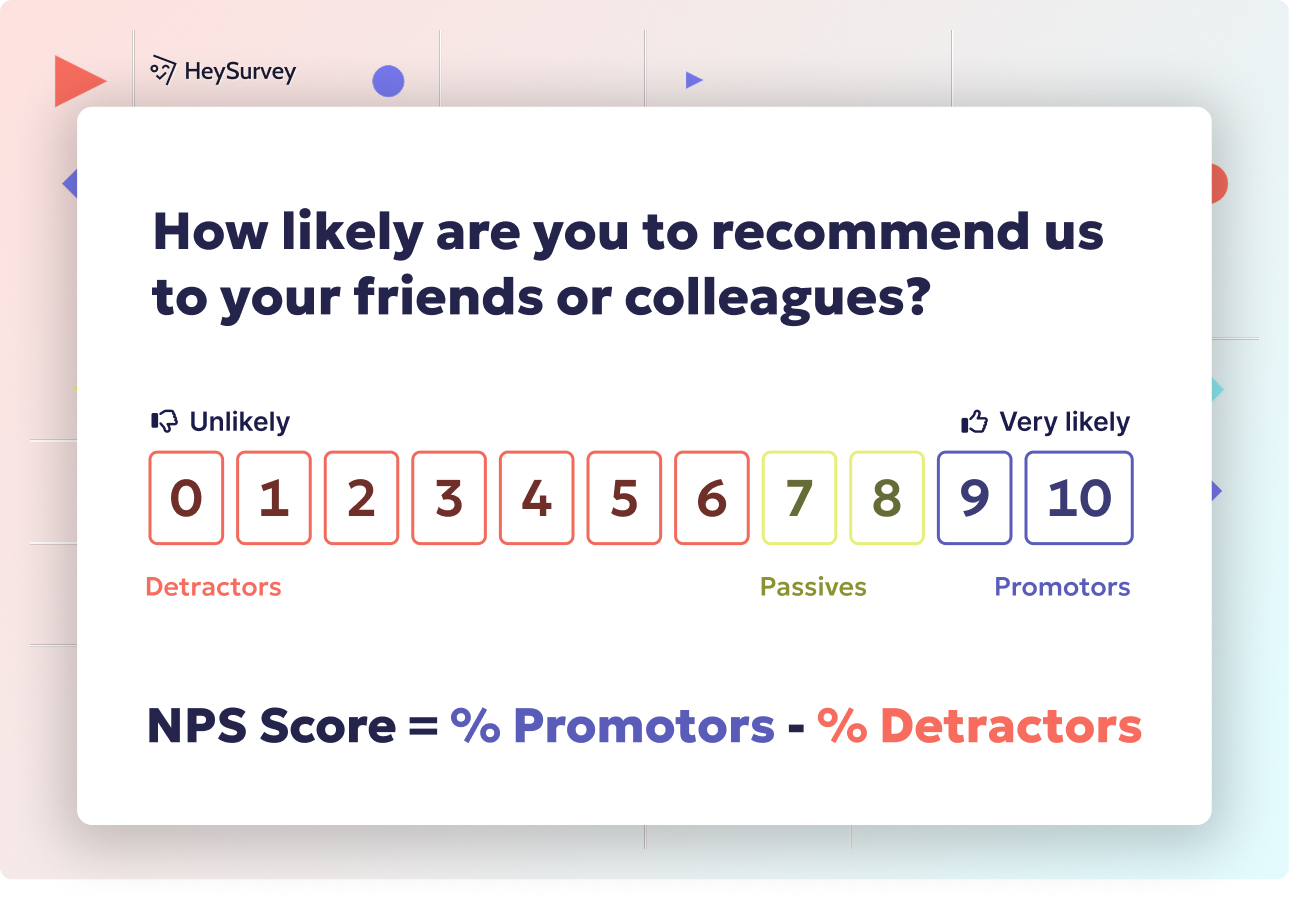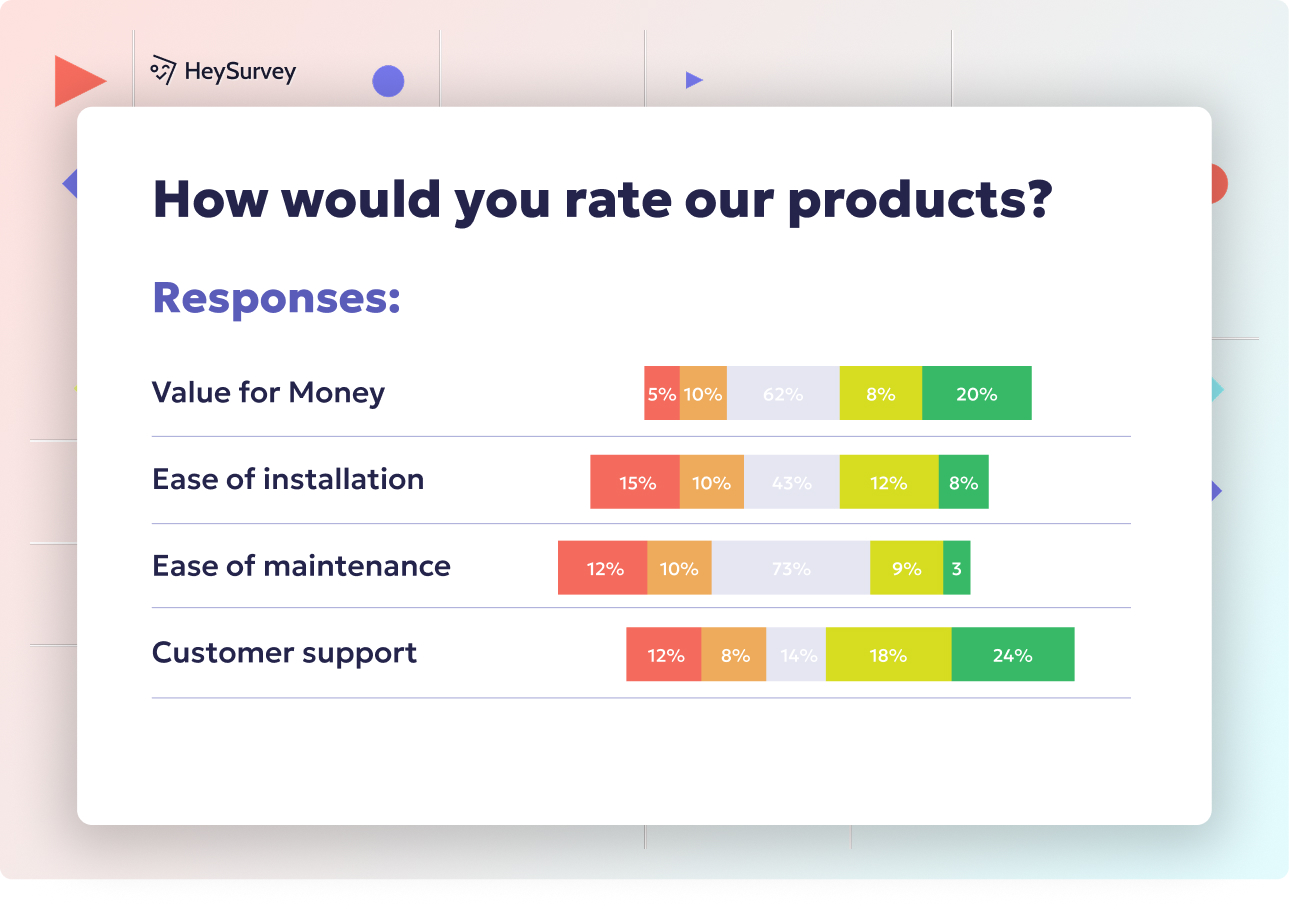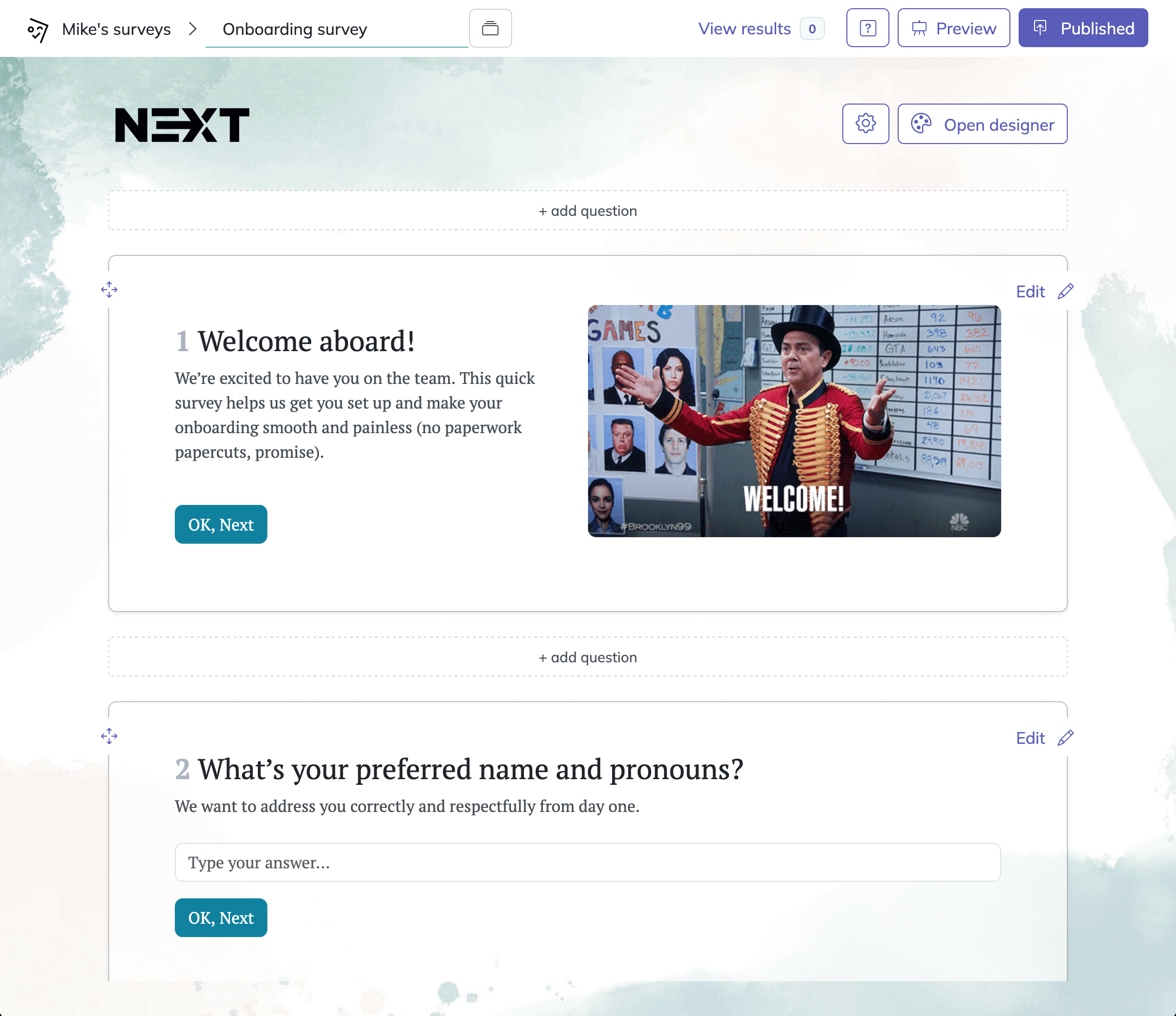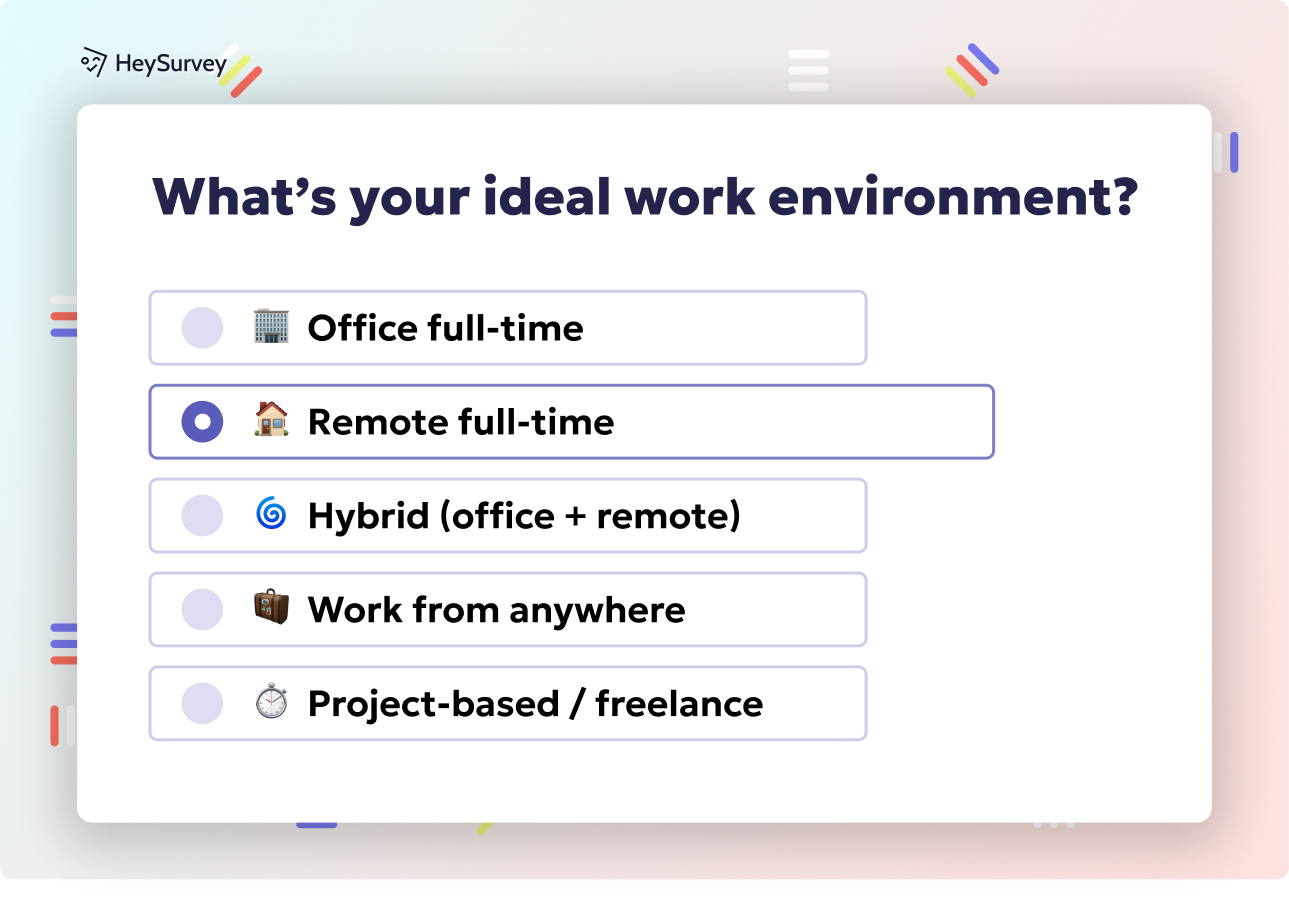30 Employee Survey Questions About Process Improvement Guide
Explore 28 effective employee survey questions about process improvement, with sample Likert, open-ended, ranking & diagnostic questions to optimize workflows.
Process-improvement in the workplace is a bit like upgrading your car’s engine while you’re driving down the highway—tricky, but vital for getting smoother, faster performance. Targeted employee surveys are a secret supercharger, uncovering hidden bottlenecks, boosting efficiency, and building a real spirit of continuous improvement. Whether your team is dealing with frustrating error rates, tackling new software, or cleaning up after a big merger, the right survey at the right time can help optimize internal workflows, reduce operational friction, and even spark some employee-driven innovation.
Likert-Scale Process-Improvement Questions
Finding Quantitative Clarity in the Everyday
There’s something soothing about numbers—they make elusive problems seem concrete and solvable. Likert-scale questions are ideal for putting those numbers to work, allowing you to measure employee satisfaction with processes, track incremental improvements, and build tidy graphs for the quarterly review meeting. When business leaders want to see where their processes land today—and how much ground they’ve gained next month—the Likert scale is their best friend.
You’ll want to roll these out when you’re benchmarking existing workflows or gauging employee sentiment after changes. After all, you can’t improve what you don’t measure, and a scale of 1-5 (or 1-7, if you’re feeling fancy) gives everyone a common language.
- Quantifies gray areas of process clarity or efficiency
- Excellent for setting baseline metrics and watching progress soar—or stall
- Unmasks gaps between leadership perceptions and employee reality
Here are five example Likert-style questions that will let you measure and compare results over time:
On a scale of 1-5, our task-handoff process is clearly defined.
The tools provided help me complete my daily work efficiently.
Communication channels for reporting process issues are accessible and effective.
I believe the current workflow minimizes unnecessary steps.
Changes to procedures are communicated clearly and timely.
With these questions, you can track incremental improvements and make more confident decisions about which areas actually need fixing. The data helps create a real-time dashboard of employee satisfaction with processes and highlights small victories along the way.
Benchmarking for Long-Term Wins
Your Likert-scale results are also perfect for benchmarking. Quarterly or annual check-ins mean you’ll quickly spot trends, good or bad. The beauty of it all? Concrete numbers on the table beat vague impressions every time. And when your CEO asks, “Where are we actually improving?” you’ll have the charts to prove it.
Implementing action plans based on employee survey feedback can lead to a 10% increase in employee engagement scores. (gallup.com)

How to Create Your Process-Improvement Survey with HeySurvey in 3 Easy Steps
Starting your process-improvement survey with HeySurvey is a breeze—even if you’re brand new to the platform. Follow these three simple steps, and you’ll be gathering employee insights in no time. Ready? Let’s dive in!
Step 1: Create a New Survey
- Head over to HeySurvey and click Create New Survey. You can start from scratch or pick a handy pre-built template to save time.
- Psst… there’s a button right below these instructions to open a tailored process-improvement survey template—try that if you want a ready-to-go setup!
- Give your survey a name that fits your project, like “Q2 Workflow Improvement.” This name is just for your eyes in the editor, so keep it clear and simple.
That’s it for Step 1! You now have a survey framework ready for your magic touch.
Step 2: Add Questions
- Click Add Question at the top or between existing questions. HeySurvey offers tons of question types perfect for process improvement—Likert scales, open-ended text, multiple choice, ranking, matrix grids, and more.
- Type your question text, add descriptions or examples if you want, and set whether the question is required.
- Want to get fancy? For multiple-choice questions, enable the “Other” option so employees can add their own input. For ranking, choose the orderable list question.
- Don’t forget that you can tweak your choices, add images, or apply markdown formatting to make your questions clear and engaging.
- If you want to streamline your survey, use branching logic—control which questions appear based on previous answers (more on that below).
Building your questions this way ensures you capture the right feedback to help optimize internal workflows.
Step 3: Publish Your Survey
- When you’re happy with your survey, click the Preview button to see exactly what your respondents will experience. Check that everything flows smoothly.
- If satisfied, hit Publish. You’ll get a shareable link ready to send to your team via email, chat, or embed on an internal site.
- Note: you’ll need to create a free account before publishing so HeySurvey can save your results safely.
Your survey is live and ready to help reduce operational friction!
Bonus Steps to Take Your Survey to the Next Level
Apply Branding
- Make your survey look like it came straight from your company! Upload your logo via the Branding section so employees instantly recognize it.
- Customize colors, fonts, and backgrounds in the Designer Sidebar to match your corporate style or the vibe of your team.
Define Survey Settings
- Set start and end dates to control when your survey is open for responses.
- Consider enabling a response limit if you only want a specific number of participants.
- Add a redirect URL to guide people to a “Thank You” page or next project after they finish.
- Decide if respondents can view aggregated results after completing the survey—it’s a nice way to close the feedback loop.
Use Branching / Skip Logic
- Branching lets you create adaptive surveys that show only relevant questions based on prior answers. This keeps the survey short and engaging and helps improve completion rates.
- For example, if someone answers “Yes” to a delay in the onboarding process, HeySurvey can automatically present a follow-up open-ended question asking what caused the delay.
- Set branching by editing the question and defining, for each answer option, which question should come next.
Once you’re all set up, hit publish and watch your employee-driven innovation take off. Don’t forget: the key to a great process-improvement survey is combining clear, measurable questions with spaces for rich feedback—and HeySurvey makes that as simple as pie. Ready to give it a spin? Use the template below and start gathering insights today!
Open-Ended Feedback Questions
Unlocking Root Causes and Unfiltered Ideas
Sometimes, numbers aren’t enough. Open-ended feedback questions encourage employees to share detailed thoughts and surface the root causes behind snags or inefficiencies. When issues are as clear as mud—or when you want to hear the next big idea for improvement—this question style shines brightest. Plus, people really love being asked, “What do you think?”
These questions fit best when: - Processes are newly launched, and you need honest input to tweak them - Employees keep bumping into “mystery obstacles” or gaps no one can quite name - Leadership wants to tap into employee-driven innovation and process improvement ideas
To get the most actionable insights, frame every question with a “What,” “How,” or “Which.” This opens the door for stories and specifics, not just yes/no answers.
Here are five open-ended prompts for process-improvement surveys:
What steps in the onboarding process do you find confusing or time-consuming?
How can we improve the procurement approval workflow to make it faster?
Which aspect of your daily routine feels most inefficient, and why?
What’s one change you believe would have the biggest impact on our workflow?
How do you suggest we make cross-department collaboration smoother?
Long-tail feedback like this helps to build holistic stories around your process challenges. Sometimes, the most surprising and valuable insights come from the side comments or “by-the-way” answers. Encourage honesty and creativity; over time, you’ll likely see themes and recurring suggestions—your very own treasure map for improvement.
Maximizing Value from Employee Voice
Open questions create a narrative, not just a scorecard. They help uncover pain points hiding between the lines and let you tap into real-world expertise. The more transparent and open the forum, the more innovative—and honest—the answers will be.
Open-ended survey questions can uncover detailed insights into employee experiences and process inefficiencies, but they may also lead to challenges in data analysis and lower response rates. (cultureamp.com)
Multiple-Choice Diagnostic Questions
Laser-Focused Analysis for Known Trouble Spots
Multiple-choice diagnostic questions speed up the data crunch, especially when you already suspect where the problems are lurking. By letting people select one or more options, you can instantly identify pain points and root out the most common bottlenecks, fueling a targeted approach to process improvement. It’s like using a metal detector instead of digging up the whole beach.
This format works best when: - You have an idea of the usual suspects—think software glitches, training gaps, or slow approvals - Fast data analysis is needed to inform quick fixes or iterative testing - Root-cause analysis is your top priority before sinking resources into solutions
Your survey can make it easy for employees to pick all that applies, revealing patterns you may never have seen coming.
Here are five multiple-choice process-improvement questions you might use:
Which step in the onboarding process causes the most delays?
- Submitting paperwork
- Waiting for equipment
- System access setup
- Training scheduling
- None of the above
- Submitting paperwork
What is the primary source of confusion in our project management system?
- Task assignments
- Status updates
- File location
- Communication logs
- Other (please specify)
- Task assignments
Which resource often slows down your work?
- Software tools
- Document templates
- Policies and procedures
- Approvals
- Other
- Software tools
Where do you encounter the most redundant steps?
- Expense reporting
- Purchase orders
- Time tracking
- Leave requests
- None
- Expense reporting
Which factor most often contributes to errors?
- Ambiguous instructions
- Inadequate training
- Lack of feedback
- Tight deadlines
- Other
- Ambiguous instructions
Using these questions in a process bottleneck survey makes it much easier to prioritize fixes and refine operations. By streamlining your questions, you get actionable data without overwhelming staff with too much open-ended work.
Actionable Patterns, Instantly
With multiple-choice diagnostics, patterns stand out in a flash. Easy-to-scan reports help you and your leadership team make quick, smart decisions about next steps—because sometimes, you just have to know where to dig.
Ranking (Priority-Setting) Questions
Giving Employees a Say in What Matters Most
Resources are always limited, and every improvement can’t happen at once. That’s where ranking questions come to the rescue, giving employees the chance to prioritize process fixes and help steer where limited time and budget will have the biggest impact. It’s the democratic way to divvy up your attention—and it yields truly data-driven resource allocation.
Leaders love ranking questions when: - There are five great ideas, but not enough budget to try them all at once - Team members disagree on which documentation update matters most - You need buy-in before making a big change
With ranking, you: - Cut through the noise and spotlight what matters most to employees - Gain confidence that your next improvement project will have actual support - Help avoid resource allocation that’s out of sync with genuine need
Try these five priority-setting prompts in your surveys:
Rank the following documentation updates from most to least urgent: system manuals, HR policies, safety procedures, onboarding checklists, project guidelines.
Prioritize these process improvements: reduce approval times, improve IT support responsiveness, update equipment, streamline communications, enhance remote collaboration.
Order the following training needs by importance: new software, compliance, soft skills, leadership, time management.
Arrange these communication tools by frequency of use: email, chat, video calls, intranet, task tracker.
Rate which workflow changes would benefit your team most: automated reporting, cross-department check-ins, error-prevention tools, clearer escalation paths, simplified forms.
Seeing employee-ranked lists turns fuzzy opinions into a clear road map for where to invest energy next. With this approach, you can confidently prioritize improvements, knowing your team will feel listened to, not steamrolled.
From Employee Voices to Actionable Change
Ranking isn’t just about numbers—it’s a compass. By letting every team member help set direction, you create a culture of real engagement and accountability for continuous improvement.
Implementing ranking questions in employee surveys enables organizations to prioritize process improvements effectively by aligning resource allocation with employee-identified needs. (supersurvey.com)
Matrix / Grid Questions
Comparing Complex Processes on Multiple Fronts
Sometimes you need a high-level comparison: how do several critical processes stack up when it comes to clarity, speed, and accuracy? Enter the matrix or grid question style—a powerhouse for holistic process performance assessment that packs a lot of insight into one tidy table.
Matrix questions shine when: - You need to compare multiple processes across several performance measures all at once - Leadership wants a big-picture view rather than isolated data points - You want to catch weak spots or color in strengths you didn’t expect
It’s efficient, thorough, and easy on the eyes.
Here are five sample matrix/grid statements for your next survey, wanting employees to rate (e.g., from “strongly disagree” to “strongly agree”):
The communication process in our department is clear and reliable.
Task handoffs between teams are completed quickly and accurately.
Our quality assurance procedures reduce errors effectively.
Training materials for new systems are comprehensive and understandable.
Cross-team collaboration tools enhance my ability to do my job.
Matrix and grid questions give you a heat map for where things are working—or faltering—across the whole operation. Employees can rate multiple processes against crucial criteria, giving you multilayered insights in one fell swoop.
Comprehensive, Fast, and Actionable
A well-designed grid does in five minutes what would take five separate surveys to uncover. The ability to diagnose at a glance makes these questions essential for senior leaders aiming for targeted, impactful process improvements.
Branching (Skip-Logic) Yes/No Questions
Adaptive Surveys That Feel Effortless
No one likes a long, dreary survey—especially if it’s full of irrelevant questions. Branching (skip-logic) yes/no questions make surveys feel smarter by adapting to every employee’s unique experience. Employees only answer what’s relevant, so you get better data and improve completion rates.
This approach is ideal when: - Different teams or roles experience processes differently - You want just-in-time follow-ups instead of blanketing everyone with the same generic queries - Lowering survey abandonment is a priority
The secret is adding simple yes/no stems with targeted, conditional follow-ups: - If they say yes, give them a deeper follow-up. - If they say no, skip that section and move on.
Try these five branching examples (with logic outlined):
Do you face any delays in the current purchase approval process?
- Yes → What is the primary source of those delays?
- No → Move to the next question
- Yes → What is the primary source of those delays?
Is it easy to find relevant policies when needed?
- No → Which policies are hardest to locate?
- Yes → Skip to next section
- No → Which policies are hardest to locate?
Have you used the new training portal in the last month?
- Yes → How would you rate its usability?
- No → Why haven’t you used it yet?
- Yes → How would you rate its usability?
Do you feel you can speak up if you notice a process issue?
- No → What would help you feel more comfortable sharing feedback?
- Yes → Have you shared feedback recently?
- No → What would help you feel more comfortable sharing feedback?
Have you experienced any errors during task handoff in the past month?
- Yes → What contributed most to those errors?
- No → Move to next process area
- Yes → What contributed most to those errors?
With this adaptive survey design, participants breeze through, and you get just the insights you need—no filler, no fatigue. Lower drop-out rates mean more trustworthy results and a better picture of what’s really working.
Streamlined and Personalized
Skip logic is the digital magic that keeps surveys relevant, focused, and minimally intrusive. The result? Happier employees and more actionable insights with every round.
Best Practices: The Dos and Don’ts of Process-Improvement Surveys
The Essential Dos
Building a successful process-improvement survey isn’t just about picking the right questions; it’s about crafting an experience that unlocks honesty and inspires action. Follow these essential “dos”:
- Test your survey with a small, diverse pilot group before rolling it out.
- Guarantee anonymity to ensure honest feedback, especially about sensitive processes.
Communicate clear, actionable timelines for when results will be shared and next steps will happen.
Use a mix of quantitative and open-ended questions for richer insights.
Regularly update and refresh your survey based on recent process changes.
Report back to staff on findings, demonstrating commitment to a continuous improvement loop.
The Major Don’ts
Nothing tanks a survey—and the trust that comes with it—quicker than classic pitfalls. Here’s what to avoid:
- Don’t load questions with bias or assumptions (leading questions cloud the real story).
- Don’t bombard employees with too many surveys, risking survey fatigue.
Don’t ignore the qualitative insights just because they’re messier to analyze.
Don’t share results in a vacuum—failing to close the loop erodes engagement and trust.
Don’t rely on a one-size-fits-all format; tailor every survey to your unique organizational quirks.
Don’t ask for feedback unless you’re prepared to act on the results—nothing kills enthusiasm faster.
By sticking to these simple guidelines, you’ll consistently generate actionable insights that keep your improvement engine humming.
Conclusion & Next Steps
The real magic of process-improvement surveys comes from mixing structured questions with open feedback, capturing both trends and the “why” behind them. When you combine Likert scales, branching, open ends, and clever ranking, you get a survey that uncovers not only what’s broken, but where to go next. Remember to always A/B test your survey styles, and above all, close the feedback loop—report outcomes back to your team! Ready to get started? Download a free process-improvement survey template and watch your internal workflows evolve.
Related Employee Survey Surveys

29 Essential Post Mortem Survey Questions for Project Success
Discover 25+ essential post mortem survey questions to improve projects, boost team morale, and d...

31 Change Readiness Survey Questions to Boost Your Success
Discover 25+ sample change readiness survey questions to assess attitudes, barriers, and confiden...

31 Retreat Survey Questions to Collect Actionable Feedback
Discover 26 essential retreat survey questions to gather actionable feedback before, during, and ...

